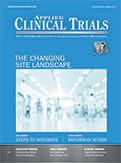Taking Care of Site Business
Applied Clinical Trials
A view of highlights and trends from the September 2019 issue, alongside trends mentioned around site practices during the year.
Lisa Henderson

I’m really excited about this issue of
Applied Clinical Trials
. Tagged as “The Changing Site Landscape,” this is our foray to update information presented in
September 2018
around different site models and bringing clinical trials closer to the point of care. This year, we offer a more in-depth look at representative models that are changing the way investigative sites work. The “traditional, dedicated research site” is morphing to model more efficient, professional, and technologically robust practices and processes that rival those of CROs, while specialty physician groups and large IDNs integrate professional providers that operationalize clinical research within their unique clinical care workflows. Academic centers, long the bastion of both innovation and bureaucracy associated with clinical trial conduct, have instituted change to streamline their business. And at the Veteran’s Administration, executives are attacking their own bureaucracies to unify study start-up and make VA clinics a competitive option for sponsored research. What follows are highlights of trends from this issue, as well as trends heard around site practices during the year.
Professionalism. One recognized problem at sites is the varying levels of performance quality and consistency in staff capabilities. There are many ways now available to help clinical research professionals, as well as sites, establish credibility and professionalism. For example, the Alliance for Clinical Research Excellence and Safety (ACRES) recently announced it will begin to accredit investigative sites. The Association of Clinical Research Professionals (ACRP) offers certifications of varying clinical research roles, as does the UK-based International Academy of Clinical Research (IAOCR). ACRP also rolled out its ACRP Core Competency Framework two years ago, initiated so industry could begin to level set the various roles at sites and is discussed as a tool used by many in our main feature.
Remote Trials. There is some backlash around the terminology of remote or virtual trials. While many have started calling them decentralized trials, these trials really are around patient centricity and making convenience and location (or inability to get to a site location more specifically) a reality for participants. Clearly, decentralized trials are reserved for the most appropriate of therapeutic areas and populations. More often than not, hybrid trials is the word of the day and means that you offer patients a mix of both on-site and virtual. To that end, sites are incorporating technologies that enable them to be more competitive for the hybrid models.
Remove Recruitment from the Site. I attended a meeting where physician speakers discussed their role as clinical event adjudicators. One view shared was that sponsors or CROs spend about 1% of their time educating the investigative staff on the study protocol, and 99% on patient recruitment. The physicians felt this time allocation should be flipped given the importance of protocol adherence for both data and safety reasons. Given the dire straits of patient enrollment, as well as the diverse ways to reach potential participants, it makes sense to take recruitment out of the core site responsibility, and make it a more strategic process.
Lisa Henderson is Editor-in-Chief of Applied Clinical Trials. She can be reached at lhenderson@mmhgroup.com. Follow Lisa on Twitter: @trialsonline

Improving Relationships and Diversifying the Site Selection Process
April 17th 2025In this episode of the Applied Clinical Trials Podcast, Liz Beatty, co-founder and chief strategy officer, Inato, discusses a number of topics around site engagement including community-based sites, the role of technology in improving site/sponsor relationships, how increased operational costs are impacting the industry, and more.
Behind the Buzz: Why Clinical Research Leaders Flock to SCOPE Summit
February 7th 2025In this episode, we meet with Micah Lieberman, Executive Conference Director for SCOPE Summit (Summit for Clinical Ops Executives) at Cambridge Innovation Institute. We will dive deep into the critical role of collaboration within the clinical research ecosystem. How do we bring together diverse stakeholders—sponsors, CROs, clinical trial tech innovators, suppliers, patients, sites, advocacy organizations, investors, and non-profits—to share best practices in trial design, program planning, innovation, and clinical operations? We’ll explore why it’s vital for thought leaders to step beyond their own organizations and learn from others, exchanging ideas that drive advancements in clinical research. Additionally, we’ll discuss the pivotal role of scientific conferences like SCOPE Summit in fostering these essential connections and collaborations, helping shape the future of clinical trials. Join us as we uncover how collective wisdom and cross-industry partnerships are transforming the landscape of clinical research.
FDA-Approved Gene Therapy Beqvez Shows Sustained Efficacy, Safety in Long-Term Hemophilia B Trial
April 17th 2025Beqvez (fidanacogene elaparvovec), an FDA-approved one-time gene therapy for hemophilia B, demonstrated sustained factor IX expression, low bleeding rates, and a favorable safety profile over long-term follow-up.